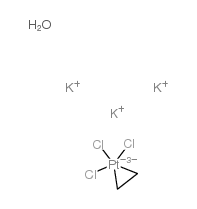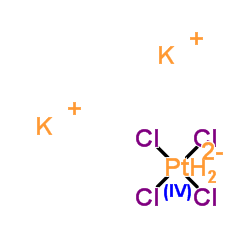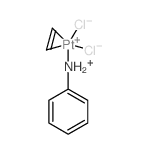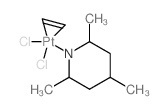12012-50-9
| Name | potassium,ethene,platinum(2+),trichloride |
|---|---|
| Synonyms |
Platinate(1-),trichloroethylene-,dipotassium
Platinate(1-),trichloro(ethylene)-,potassium potassium trichloro(ethene)platinate(II) Potassium trichloroethyleneplatinate Potassium trichloro(ethylene)platinate(II) Platinate(1-),trichloro(eta2-ethene)-,potassium Potassium ethylenetrichloroplatinate(II) Pt-93 Zeise-salt EINECS 234-577-7 |
| Molecular Formula | C2H6Cl3K3OPt |
|---|---|
| Molecular Weight | 464.80000 |
| Exact Mass | 462.80400 |
| PSA | 9.23000 |
| LogP | 2.92330 |
Synonym:Zeise's sal Section 2 - COMPOSITION, INFORMATION ON INGREDIENTS
Risk Phrases: 36/37/38 Section 3 - HAZARDS IDENTIFICATION EMERGENCY OVERVIEW
Irritating to eyes, respiratory system and skin.Hygroscopic (absorbs moisture from the air). Potential Health Effects Eye: Causes eye irritation. Skin: Causes skin irritation. Ingestion: May cause irritation of the digestive tract. Inhalation: Causes respiratory tract irritation. Chronic: Not available. Section 4 - FIRST AID MEASURES Eyes: Flush eyes with plenty of water for at least 15 minutes, occasionally lifting the upper and lower eyelids. Get medical aid. Skin: Flush skin with plenty of water for at least 15 minutes while removing contaminated clothing and shoes. Get medical aid if irritation develops or persists. Ingestion: Get medical aid. Wash mouth out with water. Inhalation: Remove from exposure and move to fresh air immediately. Get medical aid if cough or other symptoms appear. Notes to Physician: Section 5 - FIRE FIGHTING MEASURES General Information: As in any fire, wear a self-contained breathing apparatus in pressure-demand, MSHA/NIOSH (approved or equivalent), and full protective gear. Extinguishing Media: Use foam, dry chemical, or carbon dioxide. Section 6 - ACCIDENTAL RELEASE MEASURES General Information: Use proper personal protective equipment as indicated in Section 8. Spills/Leaks: Vacuum or sweep up material and place into a suitable disposal container. Section 7 - HANDLING and STORAGE Handling: Avoid breathing dust, vapor, mist, or gas. Avoid contact with skin and eyes. Storage: Store in a cool, dry place. Store in a tightly closed container. Section 8 - EXPOSURE CONTROLS, PERSONAL PROTECTION Engineering Controls: Facilities storing or utilizing this material should be equipped with an eyewash facility and a safety shower. Exposure Limits CAS# 12012-50-9: United States OSHA: 0.002 mg/m3 TWA (as Pt) (listed under Platin soluble salts). Belgium - TWA: (listed as platinum soluble salts): 0.002 mg/m3 VL (as Pt) Japan: (listed as platinum soluble salts): 0.001 mg/m3 OEL (as Pt Malaysia: (listed as platinum soluble salts): 0.002 mg/m3 TWA (as Netherlands: (listed as platinum soluble salts): 0.002 mg/m3 MAC Pt) Personal Protective Equipment Eyes: Wear chemical splash goggles. Skin: Wear appropriate protective gloves to prevent skin exposure. Clothing: Wear a chemical apron. Respirators: A NIOSH/MSHA approved air purifying dust or mist respirator or European Standard EN 149. Section 9 - PHYSICAL AND CHEMICAL PROPERTIES Physical State: Solid Color: yellow-green Odor: Not available. pH: Not available. Vapor Pressure: Not available. Viscosity: Not available. Boiling Point: Not available. Freezing/Melting Point: 220 deg C dec Autoignition Temperature: Not available. Flash Point: Not available. Explosion Limits, lower: Not available. Explosion Limits, upper: Not available. Decomposition Temperature: Solubility in water: Specific Gravity/Density: Molecular Formula: C2H4Cl3KPt.H2O Molecular Weight: 386.60 Section 10 - STABILITY AND REACTIVITY Chemical Stability: Not available. Conditions to Avoid: Exposure to moist air or water. Incompatibilities with Other Materials: Strong oxidizing agents. Hazardous Decomposition Products: Hydrogen chloride, carbon monoxide, carbon dioxide. Hazardous Polymerization: Has not been reported. Section 11 - TOXICOLOGICAL INFORMATION RTECS#: CAS# 12012-50-9: TP1880000 LD50/LC50: Not available. Carcinogenicity: Potassium trichloro(ethylene)platinate(II) monohydrate - Not listed by ACGIH, IARC, or NTP. Other: See actual entry in RTECS for complete information. Section 12 - ECOLOGICAL INFORMATION Section 13 - DISPOSAL CONSIDERATIONS Dispose of in a manner consistent with federal, state, and local regulations. Section 14 - TRANSPORT INFORMATION IATA Not regulated as a hazardous material. IMO Not regulated as a hazardous material. RID/ADR Not regulated as a hazardous material. Section 15 - REGULATORY INFORMATION European/International Regulations European Labeling in Accordance with EC Directives Hazard Symbols: XI Risk Phrases: R 36/37/38 Irritating to eyes, respiratory system and skin. Safety Phrases: S 26 In case of contact with eyes, rinse immediately with plenty of water and seek medical advice. S 37/39 Wear suitable gloves and eye/face protection. WGK (Water Danger/Protection) CAS# 12012-50-9: No information available. Canada CAS# 12012-50-9 is listed on Canada's NDSL List. CAS# 12012-50-9 is not listed on Canada's Ingredient Disclosure List. US FEDERAL TSCA CAS# 12012-50-9 is listed on the TSCA inventory. SECTION 16 - ADDITIONAL INFORMATION N/A |
CHEMICAL IDENTIFICATION
HEALTH HAZARD DATAACUTE TOXICITY DATA
|
| Risk Phrases | 36/37/38 |
|---|
|
~87% 
12012-50-9 |
| Literature: Shoemaker, Krista A.; Leadbeater, Nicholas E. Inorganic Chemistry Communications, 2009 , vol. 12, # 5 p. 341 - 342 |
|
~% 
12012-50-9 |
| Literature: Gmelin Handbook: Pt: MVol.D, 194, page 428 - 431 |
| Precursor 3 | |
|---|---|
| DownStream 4 | |






